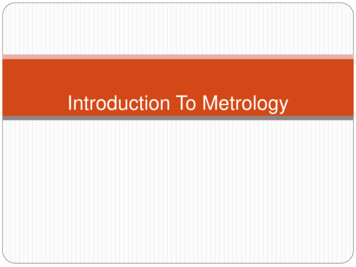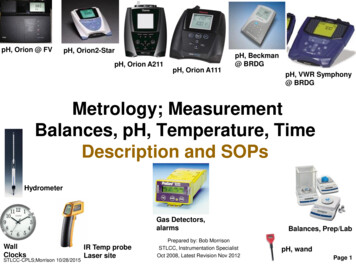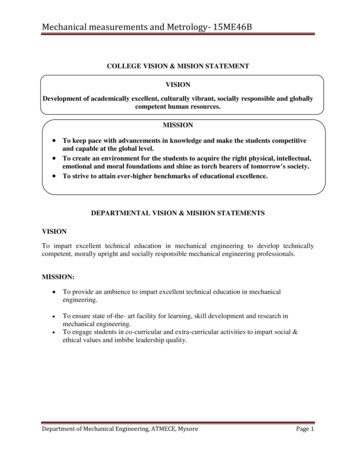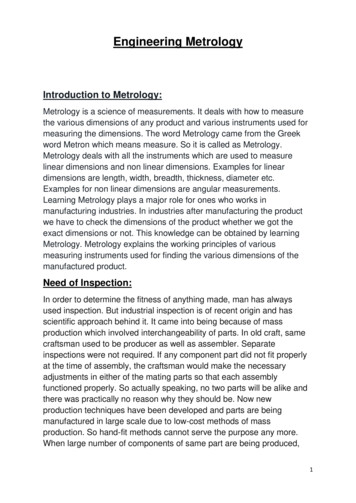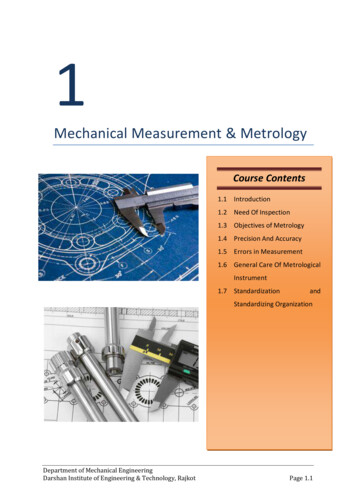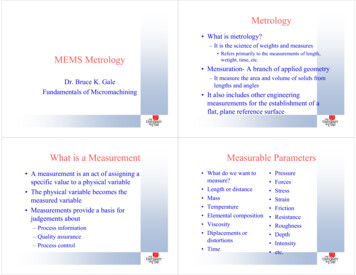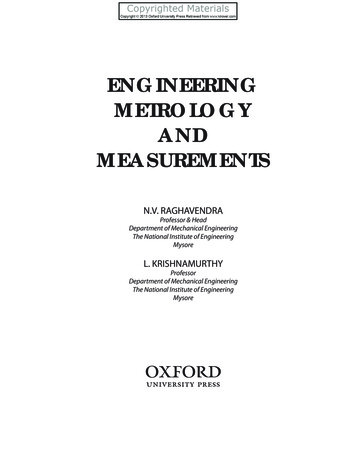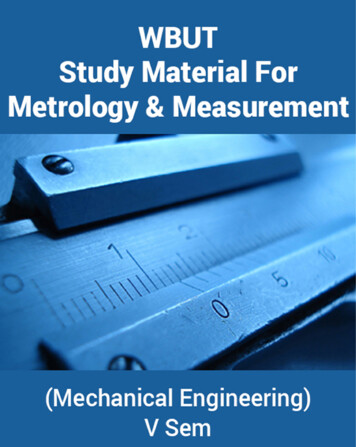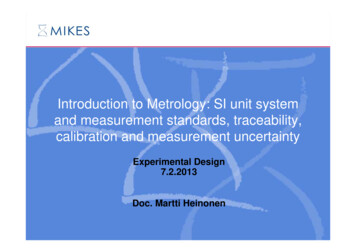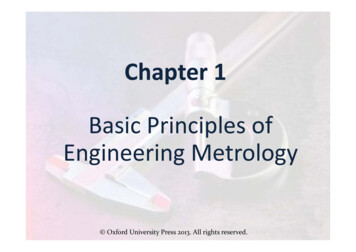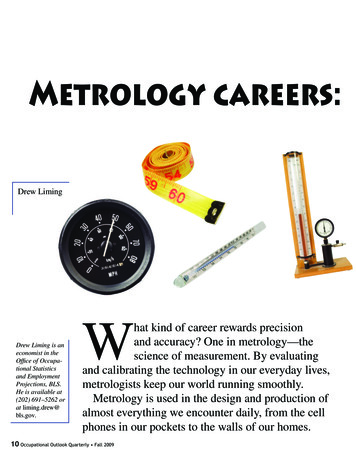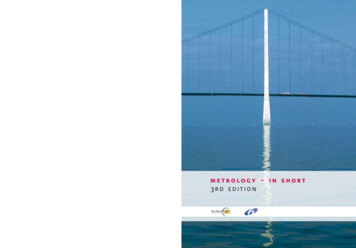
Transcription
metrology – in short3rd editionMankind measuresMetrology presents a seemingly calm surface covering depths of knowledgethat are familiar only to a few, but which most make use of – confident thatthey are sharing a common perception of what is meant by expressions suchas metre, kilogram, watt and second.metrology – in short3rd editi on
“met r o lo gy – i n s h o rt” 3rd editionJuly 2008cov e rPhoto of Great Belt east bridge, Denmark. Each of the east bridge’s 55prefabricated 48-metre, 500-ton bridge sections were measured in detailin order to adjust the four hangers which carry the section, to ensurethe correct tension. The measured, and expected, deviations from thetheoretical measurements required a hanger adjustment of 30 mm. Theadjustment of each hanger pin was determined to an accuracy of 1 mm.A wide network of contractors and subcontractors from 10 Europeancountries were involved in building the bridge 1988 - 1997. Reliableand verified measurements were essential in this huge and complexcollaboration.byPreben HowarthDanish Fundamental Metrology LtdMatematiktorvet 307DK 2800 LyngbyDenmarkpho@dfm.dtu.dkFiona RedgraveNational Physical LaboratoryHampton Road, TeddingtonTW11 0LWUnited Kingdomfiona.redgrave@npl.co.ukEURAMET project 1011, participants: DFM Denmark, NPL United Kingdom,PTB Germanyph oto g r a ph e rSøren Madsen, copyright: Sund & Bælt.designwww.faenodesign.dk 4160-0708pri ntSchultz Grafisk, DK 2620 AlbertslundISBN 978-87-988154-5-7The copyright of this booklet is held by EURAMET e.V. 2008. Permissionfor translation can be obtained from the EURAMET Secretariat. For furtherinformation, please consult the EURAMET website www.euramet.org orcontact the Secretariat: secretariat@euramet.org.d i scla i me r“Metrology - in short” 3rd edition was commissioned by the iMERA project“Implementing Metrology in the European Research Area” project, contractnumber 16220, under the 6th Framework Programme and jointly financedby the European Commission and the participating institutes. The findings,conclusions and interpretations expressed in this booklet are those of theauthors and contributors only and should in no way be taken to reflectneither the policies or opinions of the European Commission.
s u m m a ryThe main purpose of “Metrology – in short” 3rd edition is to increase awareness ofmetrology and to establish a common metrological frame of reference. It is meant toprovide users of metrology with a transparent and handy tool to obtain metrologicalinformation.Today’s global economy depends on reliable measurements and tests, which are trustedand accepted internationally. They should not create technical barriers to trade and aprecondition for this is a widely utilised and robust metrological infrastructure.The content of this handbook is a description of scientific, industrial and legal metrology.The technical subject fields of metrology and metrological units are described. Theinternational metrology infrastructure is detailed, including the regional metrologyorganisations such as EURAMET. A list of metrological terms is collected primarily frominternationally recognised standards. References are given to institutions, organisationsand laboratories by reference to their website homepages.“Metrology – in short” 3rd edition is commissioned by the iMERA “ImplementingMetrology in the European Research Area” project, contract number 16220, under the6th Framework Programme and jointly financed by the European Commission and theparticipating institutes.
ta b l e o f c o n t e n t sfo re w o rd71. i nt r o d u cti o n81.1m a n ki n d mea s u re s81.2c at eg o ri e s o f met r o lo gy101.3n ati o n a l e d iti o n s o f met r o lo gy – i n short112. met r o lo gy132.1i n d u st ri a l a n d sci e nti fi c met r o lo gy132.1.1 Subject fields132.1.2 Measurement standards162.1.3 Certified Reference Materials172.1.4 Traceability & calibration172.1.5 Metrology in chemistry172.1.6 Reference procedures192.1.7 Uncertainty212.1.8 Testing232.2leg a l met r o lo gy232.2.1 Legislation for measuring instruments232.2.2 EU Legislation for measuring instruments242.2.3 EU Enforcement of measuring instrument legislation252.2.4 Measurement and testing in legislation273. met r o lo g i c a l o rg a n i sati o n293.1i nt e rn ati o n a l i n fr a st ru ctu re293.1.1 The Metre Convention293.1.2 CIPM Mutual Recognition Arrangement 303.1.3 National Metrology Institutes 323.1.4 Designated institutes 343.1.5 Accredited laboratories 343.1.6 Regional Metrology Organisations 343.1.7 ILAC 353.1.8 OIML 353.1.9 IUPAP 363.1.10 IUPAC 373.2e u r o pea n i n fr a st ru ctu re403.2.1 Metrology – EURAMET403.2.2 Accreditation – EA413.2.3 Legal metrology – WELMEC423.2.4 EUROLAB433.2.5 Eurachem43
4.5.6.7.8. 3.2.6 COOMET3. 3a me ri c a s i n fr a st ru ctu re3.3.1 Metrology – SIM3.3.2 Accreditation – IAAC3. 4a s i a paci fi c i n fr a st ru ctu re3.4.1 Metrology – APMP3.4.2 Accreditation – APLAC3.4.3 Legal Metrology – APLMF3. 5a fri c a n i n fr a st ru ctu re3.5.1 Metrology – AFRIMETS3.5.2 Metrology – SADCMET3.5.3 Accreditation – SADCA3.5.4 Legal metrology – SADCMEL3.5.5 Other sub-regional structuresmea s u re me nt ’ s i mpact – s o me e x a mple s4. 1n atu r a l g a s4. 2ki d n ey d i a ly s i s4. 3n a n o pa rti cle s4. 4fe rti li s e r4. 5h eat met e rs4. 6fo o d sa fet y4. 7c a n ce r t reatme nt4. 8a i rcr a ft emi ss i o n s4. 9i v d d i re cti v emet r o lo g i c a l u n it s5. 1s i b a s e u n it s5. 2s i d e ri v e d u n it s5. 3u n it s o u t s i d e th e s i5. 4s i prefi x e s5. 5w riti n g o f s i u n it n a me s a n d symb o lsglo ssa ryin fo rm ati o n o n met r o lo gy – li n ksrefe re n ce 86062646667698284
forewordIt is with pleasure that we present this 3rd edition of the easy-to-use handbook“ Metrology – in short”. It is meant to provide users of metrology and the generalpublic with a simple yet comprehensive reference source on the subject. It targets thosewho are not familiar with the topic and who require an introduction, as well as thosewho are involved in metrology at various levels but who want to know more about thesubject or simply gain specific information. It is our hope that “Metrology – in short”will make it easier to understand and work with the technical and organisational aspectsof metrology. The 1st edition of the handbook, published in 1998, proved to be a verysuccessful and widely used publication throughout the metrology world, as did the 2ndedition published in 2004. This 3rd edition aims to build on this success by providing abroader scope of information to a wider target audience.The main purpose of “Metrology – in short” is to increase awareness of metrologyand to establish a common metrological understanding and frame of reference both inEurope, and between Europe and other regions throughout the world. This is particularlyimportant with the increased emphasis on the equivalence of measurement and testingservices for quality of life, environmental protection and trade and in particular wheretechnical barriers to trade are caused by metrological impediments.Since metrology evolves in line with scientific and technological advances it is necessaryto update and enhance “Metrology – in short” to take account of this evolution.Consequently the content of this 3rd edition has been broadened and updated toaddress developments in the CIPM Mutual Recognition Arrangement (MRA) and regionalmetrology, including the establishment of the legal entity EURAMET e.V. in January 2007as the new European Regional Metrology Organisation. It also contains more informationabout measurements in chemistry and biology and provides some specific examples ofhow developments in metrology have impacted the wider world.I hope that this new edition will prove to be even more popular and widely used than thefirst two editions and thereby contribute to a common metrological frame of referenceworldwide, which will ultimately promote trade between the different regions in theworld and improved quality of life for its citizens.Michael KühneEURAMET ChairmanJune 2008
1.introduction1 . 1 m a n ki n d mea s u r e sThe death penalty faced those who forgot or neglected their duty to calibrate thestandard unit of length at each full moon. Such was the peril courted by the royal sitearchitects responsible for building the temples and pyramids of the Pharaohs in ancientEgypt, 3000 years BC. The first royal cubit was defined as the length of the forearmfrom elbow to tip of the extended middle finger of the ruling Pharaoh, plus the widthof his hand. The original measurement was transferred to and carved in black granite.The workers at the building sites were given copies in granite or wood and it was theresponsibility of the architects to maintain them.Even though we feel ourselves to be a long way from this starting point, both in distanceand in time, people have placed great emphasis on correct measurements ever since.Closer to our time, in 1799 in Paris, the Metric System was created by the deposition oftwo platinum standards representing the metre and the kilogram – the forerunner of thepresent International System of Units – the SI system.In the Europe of today we measure and weigh at a cost equivalent to 6% of our combinedGNP, so metrology has become a natural and vital part of our everyday life: Coffee andplanks of wood are both bought by weight or size; water, electricity and heat aremetered, and that affects our private economies. Bathroom scales affect our humour– as do police speed traps and the possible financial consequences. The quantity ofactive substances in medicine, blood sample measurements, and the effect of thesurgeon’s laser must also be precise if patients’ health is not to be jeopardised. We findit almost impossible to describe anything without referring to weights and measures:Hours of sunshine, chest measurements, alcohol percentages, weights of letters, roomtemperatures, tyre pressures . and so on. Just for fun, try holding a conversationwithout using words that refer to weights or measures.Then there is commerce, trade and regulation that are just as dependent on weightsand measures. The pilot carefully observes his altitude, course, fuel consumption andspeed, the food inspectorate measures bacteria content, maritime authorities measurebuoyancy, companies purchase raw materials by weights and measures, and specify theirproducts using the same units. Processes are regulated and alarms are set off becauseof measurements. Systematic measurement with known degrees of uncertainty is oneof the foundations of industrial quality control and, generally speaking, in most modernindustries the costs bound up in taking measurements constitute 10-15% of production
costs. Good measurements can however significantly increase the value, effectivenessand quality of a product.Finally, science is completely dependent on measurement. Geologists measure shockwaves when the gigantic forces behind earthquakes make themselves felt, astronomerspatiently measure the dim light from distant stars in order to determine their age, atomicphysicists wave their hands in the air when by making measurements in millionths of asecond they are able at last to confirm the presence of an almost infinitesimally smallparticle. The availability of measuring equipment and the ability to use it effectively areessential if scientists are to be able to objectively document the results they achieve.The science of measurement – metrology – is probably the oldest science in the worldand knowledge of how it is applied is a fundamental necessity in practically all sciencebased professions!Measurement requires common knowledgeMetrology presents a seemingly calm surface covering depths of knowledge that arefamiliar only to a few, but which most make use of – confident that they are sharing acommon perception of what is meant by expressions such as metre, kilogram, litre, watt,etc. Confidence is vital in enabling metrology to link human activities together acrossgeographic and professional boundaries. This confidence becomes enhanced with theincreased use of network co-operation, common units of measurement and commonmeasuring procedures, as well as the recognition, accreditation and mutual testing ofmeasuring standards and laboratories in different countries. Mankind has thousandsof years of experience confirming that life really does become easier when peopleco-operate on metrology.Metrology is the science of measurementMetrology covers three main activities:1. The definition of internationally accepted units of measurement, e.g. the metre.2. The realisation of units of measurement by scientific methods, e.g. the realisationof a metre through the use of lasers.3. The establishment of traceability chains by determining and documenting thevalue and accuracy of a measurement and disseminating that knowledge, e.g. thedocumented relationship between the micrometer screw in a precision engineeringworkshop and a primary laboratory for optical length metrology.
Metrology develops Metrology is essential in scientific research, and scientific research forms the basis of thedevelopment of metrology itself. Science pushes forward the frontiers of the possibleall the time and fundamental metrology follows the metrological aspects of these newdiscoveries. This means ever better metrological tools enabling researchers to continuetheir discoveries – and only those fields of metrology that do develop can continue tobe a partner for industry and research.Correspondingly, scientific, industrial and legal metrology must also develop in order tokeep pace with the needs of industry and society – and remain relevant and useful.It is the intention to continuously develop “Metrology – in short”. The best way ofdeveloping a tool is of course to collect the experience of those who use it and thepublishers would therefore be grateful for comments, be they criticism or praise. Mail toeither of the authors will be appreciated.1.2c at e g o r i e s o f m et r o l o g yMetrology is separated into three categories with different levels of complexity andaccuracy:1. Scientific metrology deals with the organisation and development of measurementstandards and with their maintenance (highest level).2. Industrial metrology has to ensure the adequate functioning of measurementinstruments used in industry, in production and testing processes, for ensuringquality of life for citizens and for academic research.3. Legal metrology is concerned with measurements where these influence thetransparency of economic transactions, particularly where there is a requirement forlegal verification of the measuring instrument.Fundamental metrology has no international definition, but it generally signifies thehighest level of accuracy within a given field. Fundamental metrology may therefore bedescribed as the top level branch of scientific metrology.10
1.3n at i o n a l e d i t i o n s o fm et r o l o g y – i n s h o r t“Metrology – in short” has been issued in a number of national or regional editions,each adapted to and describing metrology in specific countries, following the samehandbook-concept. The English editions are the international editions.By 2008 the following editions were available:Albanian: Metrologjia – shkurtPublished 2006, contact metrology@san.com.alCzech: Metrologie v kostcePublished 2002 in 2 000 copies, contact jtesar@cmi.czCroatian: Metrologija ukratkoPublished 2000 in an electronic version.Danish: Metrologi – kort og godtFirst edition published 1998 in 1 000 copies, contact pho@dfm.dtu.dkSecond edition published 1999 in 2 000 copies, contact pho@dfm.dtu.dkEnglish: Metrology – in short (international edition)1st edition published 2000 in 10 000 copies, contact pho@dfm.dtu.dk2nd edition published 2003 in 10 000 copies3rd edition published 2008 in 8 000 copies and in an electronic version.Contact pho@dfm.dtu.dk or fiona.redgrave@npl.co.ukFinnish: Metrology – in shortFirst edition published 2001 in 5 000 copies, contact mikes@mikes.fiSecond edition published 2002, contact mikes@mikes.fiIndonesian: Metrologi – sebuah pengantarPublished 2005, contact probo@kim.libi.go.idIcelandic: Agrip af MælifrædiPublished 2006, contact postur@neytendastofa.is11
Japanese: Japanese charactersPublished 2005Lebanese: ABC-guide Metrology (Both in English and Arabic language)Published 2007 in 1500 copiesLithuanian: Metrologija trumpaiFirst edition published 2000 in 100 copies, contact rimvydas.zilinskas@ktu.ltSecond edition published 2004 in 2 000 copies, contact vz@lvmt.ltMEDA region: Metrology – in short, MEDA versionPublished 2007 in 1200 copiesMEDA region: Métrologie – en bref, édition MEDAPublished 2007 in 1200 copiesPortuguese: Metrologia – em sintesePublished 2001 in 2 500 copies, contact ipq@mail.ipq.ptTurkish: Kisaca Metroloji – ikinci baskiPublished 200612
2. metrology2 . 1 i n d u s t r i a l a n d s c i e n t i f i c m e t r o l o g yIndustrial and scientific metrology are two of the three categories of metrology asdescribed in chapter 1.2.Metrological activities, calibration, testing and measurements are valuable inputs toensure the quality of many industrial and quality of life related activities and processes.This includes the need to demonstrate traceability, which is becoming just as importantas the measurement itself. Recognition of metrological competence at each level ofthe traceability chain can be established through mutual recognition agreements orarrangements, for example the CIPM MRA and ILAC MRA, and through accreditation andpeer review.2. 1 . 1 s u b j e ct fi e l d sScientific metrology is divided into 9 technical subject fields by BIPM: Acoustics, amountof substance, electricity and magnetism, ionising radiation and radioactivity, length,mass, photometry and radiometry, thermometry, time and frequency.Within EURAMET there are three additional subject fields: flow, interdisciplinary metrologyand quality.There is no formal international definition of the subfields.Table 1: Subject fields, subfields and important measurement standards.Only technical subject fields are included.sub ject fi elds u b fi e l di mp o rta ntmea s u re me nt sta n da rd smass and relatedq uantiti esMass measurementMass standards, standard balances,mass comparatorsForce and pressureLoad cells, dead-weight testers,force, moment and torque converters,pressure balances with oil/gas-lubricatedpiston cylinder assemblies, force-testingmachines, capacitance manometers,ionisation gaugesVolume and densityViscosityGlass areometers, laboratory glassware,vibration densimeters, glass capillaryviscometers, rotation viscometers,13
sub ject fi elds u b fi e l di mp o rta ntmea s u re me nt sta n da rd selectri cityandmagnetismDC electricityCryogenic current comparators,Josephson effect and Quantum Hall effect,Zener diode references, potentiometricmethods, comparator bridgesAC electricityAC/DC converters, standard capacitors,air capacitors, standard inductances,compensators, wattmetersHF electricityThermal converters, calorimeters, bolometersHigh current and highvoltageMeasurement transformers of current andvoltage, reference high voltage sourcesWavelengths andinterferometryStabilized lasers, interferometers, laserinterferometric measurement systems,interferometric comparatorsDimensional metrologyGauge blocks, line scales, step gauges,setting rings, plugs, high masters, dialgauges, measuring microscopes, optical flatstandards, coordinate measuring machines,laser scan micrometers, depth micrometers,geodetic length measuring toolsAngular measurementsAutocollimators, rotary tables, angle gauges,polygons, levelsFormStraightness, flatness, parallelism, squares,roundness standards, cylinder standardsSurface QualityStep height and groove standards,roughness standards, roughnessmeasurement equipmentTime measurementCaesium atomic clock, time intervalequipmentFrequencyAtomic clock and fountain, quartz oscillators,lasers, electronic counters and synthesisers,optical combsTemperaturemeasurement bycontactGas thermometers, ITS 90 fixed points,resistance thermometers, thermocoupleslengthtime andfreq uencythermometryNon-contact temperature High-temperature black bodies, cryogenicmeasurementradiometers, pyrometers, Si photodiodesHumidity14Mirror dew point meters or electronichygrometers, double pressure/temperaturehumidity generators
sub ject fi elds u b fi e l di mp o rta ntmea s u re me nt sta n da rd sthermometryAbsorbed dose –Medical productsCalorimeters,Ionisation chambersRadiation protectionIonisation chambers, reference radiationbeams/fields, proportional and othercounters, TEPC, Bonner neutronspectrometersRadioactivityWell-type ionising chambers, certifiedradioactivity sources, gamma and alphaspectroscopy, 4 P detectorsOptical radiometryCryogenic radiometer, optical detectors,stabilised laser reference sources, referencematerialsPhotometryVisible region detectors, Si photodiodes,quantum efficiency detectorsColorimetrySpectrophotometerOptical fibresReference materialsGas flow (volume)Bell provers, rotary gas meters, turbine gasmeters, transfer meter with critical nozzlesFlow of liquids(volume, mass andenergy)Volume standards, Coriolis mass-relatedstandards, level meters, inductive flowmeters, ultrasound flow metersAnemometryAnemometersAcousticalmeasurements ingasesStandard microphones, piston phones,condenser microphones, sound calibratorsAccelerometryAccelerometers, force transducers, vibrators,laser interferometerAcousticalmeasurements inliquidsHydrophonesUltrasoundUltrasonic power meters, radiation forcebalancephotometry andradiometryflowaco usti cs,ultraso und andvi bration15
sub ject fi elds u b fi e l di mp o rta ntmea s u re me nt sta n da rd schemistryEnvironmental chemistryClinical chemistryCertified reference materials, massspectrometers, chromatographs,gravimetric standardsMaterials chemistryPure materials, certified reference materialsFood chemistry,Biochemistry,Micro biologyCertified reference materialspH measurementCertified reference materials, standardelectrodes2.1.2 mea s u re me nt sta n da rd sA measurement standard or etalon, is a material measure, measuring instrument,reference material or measuring system intended to define, realise, conserve or reproducea unit or one or more values of a quantity to serve as a reference.ExampleThe metre is defined as the length of the path travelled by light in vacuumduring a time interval of 1/299 792 458 of a second. The metre is realisedat the primary level in terms of the wavelength from an iodine-stabilisedhelium-neon laser. On sub-levels, material measures like gauge blocksare used, and traceability is ensured by using optical interferometry todetermine the length of the gauge blocks with reference to the abovementioned laser light wavelength.The different levels of measurement standard are shown in Figure 1. Metrology fields,subfields and important measurement standards are shown in Table 1 in chapter 2.1.1.There is no international listing of all measurement standards.The definitions of the different measurement standards are given in the Glossary inchapter 6.2.1.3 ce rti fi e d refe re n ce m at e ri a lsA certified reference material (CRM) is a reference material, where one or more of itsproperty values are certified by a procedure that establishes traceability to a realisation ofthe unit, in which the property values are expressed. Each certified value is accompaniedby an uncertainty at a stated level of confidence. The term standard reference material16
(SRM) is also used in some parts of the world and is synonymous with a CRM.CRMs are generally prepared in batches. The property values are determined withinstated uncertainty limits by measurements on samples representative of the wholebatch.2. 1 . 4 t r acea b i lit y & c a li b r ati o nTraceability to the SIA traceability chain, see Figure 1, is an unbroken chain of comparisons, all having stateduncertainties. This ensures that a measurement result or the value of a standard isrelated to references at the higher levels, ending at the primary standard.In chemistry and biology traceability is often obtained by using CRMs and referenceprocedures, see chapter 2.1.3 and 2.1.6.An end user may obtain traceability to the highest international level either directlyfrom a National Metrology Institute or from a secondary calibration laboratory, usuallyan accredited laboratory. As a result of various mutual recognition arrangements,internationally recognised traceability may be obtained from laboratories outside theuser’s own country.CalibrationA basic tool in ensuring the traceability of a measurement is the calibration of ameasuring instrument, measuring system or reference material. Calibration determinesthe performance characteristics of an instrument, system or reference material. It isusually achieved by means of a direct comparison against measurement standards orcertified reference materials. A calibration certificate is issued and, in most cases, asticker is provided for the instrument.Four main reasons for having an instrument calibrated:1. To establish and demonstrate traceability.2. To ensure readings from the instrument are consistent with other measurements.3. To determine the accuracy of the instrument readings.4. To establish the reliability of the instrument i.e. that it can be trusted.17
2.1.5 met r o lo gy i n ch e mi st ryMetrology has developed from physical measurements and emphasizes results traceableto defined reference standards, normally the International System of Units (SI), withfully analysed uncertainty budgets based on the GUM [6]. The situation with respectto chemical measurements is more complex since chemical measurements often do nottake place under such controlled and defined conditions, see Table 2.Table 2: Comparison between metrology in physics and chemistrymetrology in physi csand chemistryPhysicsChemistryMeasurementComparing a quantity:e.g. temperatureComparing a quantity:e.g. DDT in milkUnitsm, s, Kmol/kg, mg/kgInfluenced by.Often relies on directmeasurementsVarious factors affects thequality of the measurementresultsMain impactEquipment calibrationChemical treatment (e.g.extraction, digestion); referencematerials used; andequipment calibrationDepends on.To a large extent sampleindependentStrongly sample dependentExampleLength of a tableConcentration of Pb in:seawater; soils, blood etc.Often the primary objective of chemical measurements is to determine the amount ofcomponents of interest, not the total composition of the sample. Total composition willtherefore almost always remain unknown and hence the total environment under whichthe measurements take place cannot be defined and controlled.Many chemical measurements are traceable to a standard or to reference methods.In other instances measurements can be considered to be traceable to a (certified)reference material, either in the form of a pure substance or of a matrix referencematerial, in which the concentration of the analyte has been certified. The degree towhich reference materials provide a universal reference (and specifically traceable to theSI) depends on the quality of the link to values obtained by reference measurements orvia links to values carried by reference standards.18
pHpH is a measure of the degree of acidity or alkalinity of an aqueous solution, whichis determined by number of available hydrogen ions, i.e. the activity (effectiveconcentration) of hydrogen ions. pH is an important concept because many chemicalprocesses and most biological processes depend critically on the degree of acidity at thesite of the reaction. Biological processes take place in environments spanning at leasttwelve orders of magnitude of hydrogen ion activity, but each specific process is usuallydependent on an environment within only a few degrees of hydrogen ion activity.2. 1 . 6 refe re n ce pr o ce d u re sReference procedures or methods can be defined as procedures of testing, measurement or analysis,thoroughly characterised and proven to be under control, intended for quality assessment of other procedures for comparable tasks, or characterisation of reference materials including reference objects, or determination of reference values.The uncertainty of the results of a reference procedure must be adequately estimatedand appropriate for the intended use.According to this definition reference procedures can be used to validate other measurement or test procedures, which are used for a similar task,and to determine their uncertainty. determine reference values of the properties of materials, which can be compiledin handbooks or databases, or reference values which are embodied by a referencematerial or reference object.19
Figure 1: The traceability chainBIPM(Bureau International desPoids et Mesures)National metrologyinstitutes or designatednational institutesCalibration laboratories,often accreditedIndustry, academia,regulators, hospitalsDEFINITION OF THE UNITFO R E I G N N AT I O N A L P RI M A RYSTA N DA R DSN AT I O N A L P RI M A RYSTA N DA R D SR E FE R E N C E STA NDA R D SWORKI N G STA N DA R D SEnd usersM E AS U R E M E N T SU N C E RTA I N T Y I N C R E A S E S D O W N T H E T R A C E A B I L I T Y C H A INThe nationalmetrological infrastructure20
2. 1 . 7 u n ce rta i nt yUncertainty is a quantitative measure of the quality of a measurement result, enablingthe measurement results to be compared with other results, references, specificationsor standards.All measurements are subject to error, in that the result of a measurement differs fromthe true value of the measurand. Given time and resources, most sources of measurementerror can be identified, and measurement errors can be quantified and corrected for, forinstance through calibration. There is, however, seldom time or resources to determ
The content of this handbook is a description of scientific, industrial and legal metrology. The technical subject fields of metrology and metrological units are described. The international metrology
